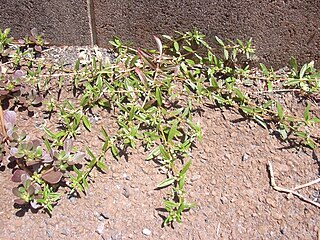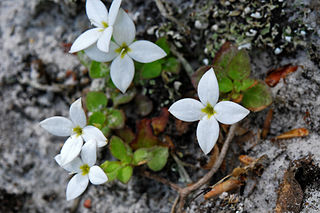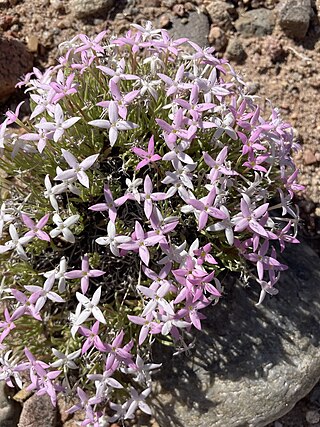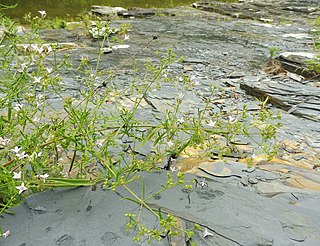
Oldenlandiopsis (creeping-bluet) is a genus of flowering plants in the family Rubiaceae. It is monospecific, comprising only one species, Oldenlandiopsis callitrichoides. This species had previously been placed in Hedyotis or in Oldenlandia. It is native to the West Indies, southern Mexico, and Central America. It is naturalized elsewhere, including Florida, Hawaii, South America, and tropical Africa.

Houstonia (bluet) is a genus of plants in the family Rubiaceae. Many species were formerly classified, along with other genera since segregated elsewhere, in a more inclusive genus Hedyotis.

Oldenlandia is a genus of flowering plants in the family Rubiaceae. It is pantropical in distribution and has about 240 species. The type species for the genus is Oldenlandia corymbosa.

Hakea teretifolia, commonly known as the dagger hakea, is a species of woody shrub of the family Proteaceae and is common on heathlands in coastal eastern Australia from northern New South Wales through to Victoria and Tasmania. A very prickly shrub, it is rarely cultivated but easy to grow.

Kadua is a genus of flowering plants in the family Rubiaceae. It comprises 29 species, all restricted to Polynesia. Twenty-two of these are endemic to the Hawaiian Islands. Some of the species are common at high elevation. Others are single-island endemics or very rare, and a few are probably extinct. Kadua affinis is widely distributed in Hawaii and is polymorphic. The type species for the genus is Kadua acuminata.

Houstonia procumbens, the roundleaf bluet, is a perennial species in the family Rubiaceae. It is native to the southeastern United States: Louisiana, Mississippi, Alabama, Georgia, Florida and South Carolina. Its native habitats include disturbed sites, and moist, open, sandy areas. Flowers bloom March to October.
Houstonia ouachitana, the Ouachita bluet, is a species of plants in the coffee family. It is endemic to the Ouachita Mountains of Arkansas and Oklahoma. It is an herb up to 20 cm tall, with lanceloate basal leaves and narrowly linear cauline leaves.
Houstonia acerosa, the New Mexico bluet or needleleaf bluet, is a plant species native to Chihuahua, Coahuila, Nuevo León, Tamaulipas, San Luis Potosí, Texas and New Mexico.
Houstonia palmeri, the Saltillo bluet, is a plant species in the family Rubiaceae, native to the Mexican states of Coahuila and Nuevo León.

Houstonia humifusa, commonly called matted bluet, is a plant species in the coffee family (Rubiaceae). It is native to the United States, where it is found in Texas, Oklahoma, and New Mexico. It is typically found in sandy areas, or sometimes over gypsum.

Houstonia micrantha, the southern bluet, is a plant species in the coffee family.
Houstonia parviflora, the few-flowered bluet or Greenman's bluet, is a plant species in the Rubiaceae, found only in south-central Texas.

Houstonia rubra, the red bluet, is a plant species in the Rubiaceae. It is a small herb with white to pink to red to reddish-purple flowers, native to the southwestern United States and northern and central Mexico: Coahuila, Nuevo León, Hidalgo, Zacatecas, Guanajuato, Puebla, Sonora, Durango, Chihuahua, Arizona, New Mexico, southeastern Utah and western Texas.

Houstonia serpyllifolia, commonly called thymeleaf bluet, creeping bluet, mountain bluet, Appalachian bluet or Michaux's bluets is a species of plant in the coffee family (Rubiaceae). It is native to the eastern United States, where it is found in the central and southern Appalachian Mountains. It has been documented in the states of Pennsylvania, Maryland, West Virginia, western Virginia, North Carolina, South Carolina, Kentucky, Tennessee, Ohio, and northeastern Georgia.
Houstonia sharpii, the Hidalgo bluet, is a plant species in the family Rubiaceae. It is a herbaceous perennial up to 30 cm tall, spreading by means of stolons spreading along the surface of the ground. It also has white flowers. It is native to the states of Hidalgo, Puebla and Veracruz in Mexico.
Houstonia spellenbergii is a plant species in the family Rubiaceae. It is native to the western part of the state of Chihuahua in northern Mexico, at an elevation of approximately 2100 m in the Sierra Madre Occidental near the Basaseáchic waterfall.

Houstonia wrightii, the pygmy bluet, is a plant species in the Rubiaceae. It is native to the south-western United States and northern Mexico.

Spermacoceae is a tribe of flowering plants in the family Rubiaceae and contains about 1346 species in 57 genera. Its representatives are found in the tropics and subtropics.

Stenaria is a genus of flowering plants in the family Rubiaceae. It is a small genus, consisting of around six species native to the United States, Mexico, and The Bahamas. All species of Stenaria are restricted to Mexico and the southwestern United States, except for the wide-ranging Stenaria nigricans which extends northward and eastward.












